
The catalyst for this research study is a particular dress I own, that I call The Bird Dress. I don’t remember exactly when I bought The Bird Dress, but I recall it was when I was an undergraduate fashion student, so it would have been around 2001. I bought it at a vintage boutique on Brunswick St in Melbourne that I visited occasionally, mostly to window shop since it was rather more expensive than the charity shops I frequented regularly. I remember that it was $48AUD which was quite a lot more than the $20AUD I would usually spend on a second-hand dress. The dress was made in Japan, by an unfamiliar brand. It is made from black polyester georgette, printed all over with small brown birds in flight. The style is simple: a straight skirt, pleated and elasticated at the waist, a wrap front bodice with a kimono style short-sleeve cut in one with the body. A belt made of the same fabric with a black and gold coloured metal buckle is held in place at the side seams with hand worked thread loops. The skirt is lined, but the bodice is not, so it requires a slip underneath. Although it is a vintage garment, the cut of the dress might be described as ‘classic’ and maintains contemporary appeal. In fact, it is difficult to tell if it was made in the 1970s or 1980s. The print is unusual in design and technique and being of high quality has withstood wash and wear well over time. As a result of its design, fabric and construction, the dress still looks to be in its original condition.
Long-lasting design
The reason I can wear it more than 15 years later is perhaps due to a number of decisions made at the time of its design and manufacture that have resulted in a robust but adaptable garment that has kept pace with the fashions changing around it. The pleated bodice, wide armholes, elasticated waistline and generous skirt are design features of the style but have also comfortably accommodated small changes in my body shape over time. Its methods of construction and the durable, easy care fabric from which it has been made have enabled me to alter it in small ways. Over the years I have adjusted the length of the belt, taking it in and letting it out at different times, I have re-stitched the hem, and I have replaced the perished waistband elastic with a longer piece. These simple alterations have kept the garment in good condition and ensured it has remained a comfortable fit. The style of the garment remains unchanged. I have not shortened its knee length skirt or chopped off its already short sleeves.
The Bird Dress story suggests that a combination of the decisions made at the time of its design (and the skill-set of the wearer) is essential for any potential strategy for improved longevity. The actions I have taken to keep this dress alive form the basis of my research practice and have helped structure the design of my study for The Living Wardrobe as a different way of approaching and building sustainable practice in fashion and design.
